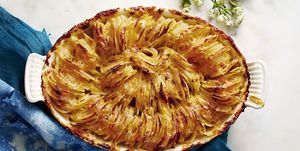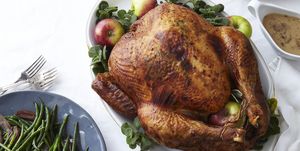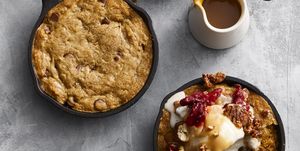Thanksgiving traditionally revolves around family, food, and (at least in my house) football. And while some of us are spending entirely too much time making spreadsheets of our favorite Thanksgiving recipes — things like turkey, stuffing, sweet potatoes, and pumpkin pie — it’s possibly even more important to remember how the holiday actually started, as well as the diverse ways we celebrate it today.
Let’s face it, lots of families need a nice, noncontroversial topic to talk about as you pass the bread basket. We’ve got you covered. From which president tried to cancel Thanksgiving to how many calories the average American puts away during the feast, these Thanksgiving facts will provide the perfect antidote to politics and those petty arguments that always seem to crop up after that one person has their third glass of wine. Not to mention, your guests will be totally impressed with all your Thanksgiving trivia knowledge. And if you need even more ways to break the ice, try sharing one of these hilarious Thanksgiving jokes or playing one of these fun Thanksgiving games.
This content is imported from {embed-name}. You may be able to find the same content in another format, or you may be able to find more information, at their web site.
1. The first Thanksgiving was actually a three-day affair.
Today, Thanksgiving takes place over one decadent day — maybe two if you count Black Friday. But the original Pilgrims really went all out. In November 1621, the settlers’ first corn harvest proved so successful, Governor William Bradford reportedly invited the Plymouth colonists’ Native American allies to enjoy the fruits of their labor. Members of the Wampanoag tribe came bearing food to share. They had so much bounty, the revelers decided to extend the affair.
2. Colonists and Native Americans may not have had turkey at their feast.
While most of us enjoy turkey as the centerpiece of our table, no one can say for sure whether it was even on the menu back in 1621. However, they did indulge in other foods like lobster, seal, and swan. The Wampanoag also reportedly brought five deer to the celebration. If you also enjoy venison at your table, consider yourselves perfectly aligned with a longstanding tradition.
3. Part of Plymouth, Mass., looks just as it did in the 17th century.
If you want to see what Thanksgiving was really like back in the 1600s, the historic attraction Plymouth (or Plimoth) Plantation stays true to its historic roots. You can even celebrate Thanksgiving at the site, which is modeled after a colonist’s home and a Wampanoag site. Guests can order tickets as early as June (or May for members) to attend a Thanksgiving dinner. The table-groaning feast features authentic courses like a corn pudding and fish fricassee, tales of colonial life, and old-timey songs. You can’t help but join in!
4. Thomas Jefferson refused to declare Thanksgiving a holiday.
Presidents originally had to declare Thanksgiving a holiday every year, up until Lincoln made it a national holiday during his tenure. However, Jefferson refused to recognize the event, because he believed so firmly in the separation of church and state. Since Thanksgiving involved prayer and reflection, he thought designating it a national holiday would violate the First Amendment. He also thought it was better suited as a state holiday, not a federal one.
5. The woman behind “Mary Had a Little Lamb” is also responsible for Thanksgiving’s recognition as a national holiday.
Writer and editor Sarah Josepha Hale convinced President Abraham Lincoln to officially declare Thanksgiving a national holiday, after three decades of persistent lobbying. The author also founded the American Ladies Magazine, which promoted women’s issues long before suffrage. She wrote countless articles and letters, advocating for Thanksgiving to help unify the Northern and Southern states amid gathering divisions. Hale kept at it, even after the Civil War broke out, and Lincoln actually wrote the proclamation just a week after her last letter in 1863, earning her the name the Mother of Thanksgiving.
6. The first Macy’s Thanksgiving Day Parade didn’t feature any balloons.
If you can’t imagine the Macy’s Thanksgiving Day Parade without giant floats featuring your favorite characters, you’d barely recognize the first parade in the early 1920s. It did have puppets riding the iconic floats, as well as singers and celebrities and of course, Santa Claus. That said, when the Thanksgiving parade made its big debut in 1924, it did have something that might be even crazier than balloons: animals from the Central Park Zoo.
7. We have a Good Housekeeping illustrator to thank for the parade’s first balloons.
German American illustrator Tony Starg, whose illustrations were featured in Good Housekeeping, also had a passion for puppetry. He used that talent to make some amazing floats come to life in 1927.
How cool is that?
8. In 1939, Thanksgiving was celebrated on the third Thursday in November — not the fourth.
You might think President Roosevelt could predict the future, as he channeled a “Black Friday” mindset when he decided to move Thanksgiving during his presidency. Even though the holiday had been celebrated on the fourth Thursday since Lincoln officially recognized the federal holiday decades before, Roosevelt bumped it up a week, and effectively added seven more shopping days to the holiday season to boost the economy. That angered football coaches who had Thanksgiving games already scheduled and calendar-printers who now had incorrect dates. Americans, to say the least, didn’t love the change, so it was officially switched back in 1942.
9. A Thanksgiving mix-up inspired the first TV dinners.
In 1953, a Swanson employee accidentally ordered a colossal shipment of Thanksgiving turkeys (260 tons, to be exact). To deal with the excess, salesman Gerry Thomas took inspiration from the prepared foods served on airplanes. He came up with the idea of filling 5,000 aluminum trays with the turkey – along with cornbread dressing, gravy, peas, and sweet potatoes to complete the offering. The 98-cents meals were a hit, especially with kids and increasingly busy households.
This content is imported from {embed-name}. You may be able to find the same content in another format, or you may be able to find more information, at their web site.
Within a single year, over 10 million were sold and a whole industry was born.
10. Americans prepare 46 million turkeys for Thanksgiving each year.
Thanksgiving without turkey would be like Christmas without a tree, and most American families wouldn’t dream of foregoing the almighty bird. While not super popular the rest of the year, turkey is a huge hit for holidays, probably because it can serve large gatherings. On Christmas, an additional 22 million families host an encore with yet another turkey.
Turns out, the bird really is the word.
11. But not everyone eats turkey on Thanksgiving.
If your family goes in a different direction on the big day, you’re not alone. According to the National Turkey Federation, 88% of Americans chow down on Thanksgiving turkey. The rest may be vegetarian or vegan, or just taking a stand against a protein that, let’s face it, doesn’t show up much the rest of the year for a reason.
This content is imported from {embed-name}. You may be able to find the same content in another format, or you may be able to find more information, at their web site.
That begs the question, what interesting dishes are the other 12% cooking up?
12. You might consume up to 229 grams fat during the big meal.
You might want to put on those stretchy pants before heading to Thanksgiving dinner (as if you needed a warning!) That’s about three to four times the amount of fat you should eat in a day. And while this is probably not news to those of us who go for second or third helpings of the big meal, the entire Thanksgiving dinner could total over 3,000 calories. Now, who’s up for tossing around the ol’ pigskin after dinner?
13. America’s first turkey trot took place more than a century ago.
The race was hosted by the local YMCA in Buffalo, NY and included just six runners — although only four of them made it to the finish line. One runner dropped out when his “late breakfast refused to keep in its proper place” and another simply excused himself after two miles. Today, turkey trots are a much bigger deal. In 2018, more than one million people were slated to finish one giant Thanksgiving race, and around 1,000 turkey trots took place around the country.
14. Runners at a Dallas turkey trot set a world record by dressing up as turkeys.
Not only are turkey trots a fun Thanksgiving tradition, many of them also offer runners the unique opportunity to dress in fun costumes commemorating the day. On Thanksgiving Day in 2011, runners at the YMCA Turkey Trot in Dallas, Texas, dressed up in droves and set a Guinness World Record for the largest gathering of people dressed as turkeys. In total, 661 people came wearing their feathered finest. Consider this your inspiration to do the same.
15. The turkeys pardoned by the president go on to live fulfilling lives.
President George H.W. Bush pardoned the first turkey in 1989 after he noticed the 50-pound bird at his official Thanksgiving proclamation looked a little nervous. Every president has upheld the tradition, ever since. But what happens to that lucky bird that lives to squawk another day? In 2005 and 2009, the turkeys went to Disneyland and Walt Disney World parks to serve as grand marshal in their annual Thanksgiving parades.
And from 2010 to 2013, they vacationed at Washington’s Mount Vernon state. Looks like the birds aren’t wasting their second shot.
16. Only male turkeys actually gobble.
If you learned in preschool that a turkey goes “gobble, gobble,” that’s only about half true. Only male turkeys — appropriately named gobblers — actually make the sound. Female turkeys cackle instead. So if you’re trying to figure out whether a turkey’s male or female, just wait until they open their beaks.
17. Turkeys are (kind of) named after the country.
No, the bid turkey does not really hail from the country Turkey. During the reign of the Ottoman Empire, a bird called the guinea fowl — which bears a striking resemblance to the American turkey — was imported to Europe from its native North Africa. Because the birds came from Turkish lands, Europeans called them the turkey-cock and turkey-hen. When settlers in the Americas began sending similar-looking birds back to Europe, the name had already stuck.
18. Most Americans prefer Thanksgiving leftovers to the actual meal.
Fans of the beloved turkey, stuffing, and mashed potato leftover sandwich: You’re in the majority. Almost eight in 10 Americans agree that the second helpings of stuffing, mashed potatoes, and of course pie beat out the big dinner itself, according to a 2015 Harris Poll.
This content is imported from {embed-name}. You may be able to find the same content in another format, or you may be able to find more information, at their web site.
Many people will craft creative leftover concoctions out of what doesn’t get consumed during the feast, or just head back for a whole second act. If you find yourself raiding the fridge, you’re in good company.
19. The Butterball Turkey Talk Line answers almost 100,000 calls each season.
So many people roast a big bird just once a year, and understandably need a little help. No question is too silly for the heroes on the other end of the line. In 2016, the company’s popular cooking crisis management team also introduced a 24-hour text message line for the lead-up into the big day. So if you’re wondering why the turkey isn’t turning out quite the way you want it – or your oven starts on fire like my firefighter father-in-law’s did one year – don’t panic. Help is just a call or a text message away.
20. Canada also celebrates Thanksgiving — but on a different day.
Our neighbors to the north also celebrate Thanksgiving, but they do so on a different day and for an unrelated reason. While American Thanksgiving pays homage to a feast between the pilgrims and the Native Americans, the Canadian celebration commemorates a feast between English explorer Martin Frobisher and his crew after their successful sail from England to the Canadian territory in 1578. Canadian Thanksgiving takes place on the second Monday of October every year.
That doesn’t mean there are zero similarities between the two holidays. Both American and Canadian Thanksgiving menus often revolve around turkey, and revelers in both countries frequently spend the day watching football marathons and festive parades. In Canada, the biggest one is the Kitchener-Waterloo Oktoberfest Thanksgiving Day Parade.
21. Four places in the country bear the name Turkey.
Diehard Thanksgiving fans can actually move to a town named after the centerpiece of their favorite holiday. The U.S. Census has identified another four named Cranberry, and a grand total of 34 dubbed Plymouth. We bet they take their turkey day celebrations very seriously.
22. Americans east an estimated 50 million pumpkin pies on Thanksgiving.
Me, I consider pumpkin pie a vehicle for whipped topping and could take it or leave it, otherwise. If you’d also rather leave your pumpkins for Halloween and dig into another Thanksgiving dessert, you’re not alone. According to The American Pie Council, more Americans prefer apple pie overall — pumpkin pie only comes in second place.
Good thing many Thanksgiving spreads feature a few different pies so you can have your pick.
23. Black Friday is the busiest day of the year for plumbers.
Thanks to all that food we gobble up on Thanksgiving and houseguests stressing out the plumbing system, Roto-Rooter reports that kitchen drains, garbage disposals, and yes, toilets, require more attention the day after Thanksgiving than any other day. Before you have to join the legions paying a hefty holiday bill, you may want to remind your kitchen clean-up crew to scrape the plates before washing.
24. Over 32 million people begin Black Friday shopping on Thanksgiving.
Even though many consumers think stores shouldn’t be open on Thanksgiving, a good chunk of us still shop on the holiday, according to the National Retail Federation. But not everyone heads to the mall before their meal settles.
Black Friday still draws the biggest crowd of the entire holiday weekend, with 115 million people. A total of 69 percent of Americans chase those deals like a retail-driven Olympic sport. That may explain why we can’t find a mall parking spot.
25. Thanksgiving’s history isn’t all sunny.
Before you tuck into your turkey and stuffing, take a moment to remember that Thanksgiving didn’t come about entirely peacefully. After the pilgrims arrived, years of conflict took place between European settlers and the Wampanoag people, which resulted in the deaths of millions of Native people. The only reason the pilgrims could even settle in Plymouth was because the Wampanoag population had been devastated by disease, virtually wiped out by a plague European settlers brought with them years before.
Since 1970, people have gathered on the last Thursday in November at the top of Cole’s Hill, which overlooks Plymouth Rock, to commemorate a “National Day of Mourning.” Similar events take place in other parts of the country to remember that, even as European settlers fled to North American to escape persecution in their own country, their arrival heralded unspeakable loss for Native people that still continues today.
This content is created and maintained by a third party, and imported onto this page to help users provide their email addresses. You may be able to find more information about this and similar content at piano.io








